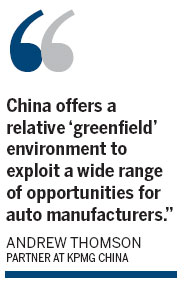"It does not seem likely that China can match such bold expectations, as a big export push - especially into mature markets - would require significant efforts to improve not only quality but also brand perceptions and distribution networks," said Thomson.
"The current top export destinations for Chinese cars are Russia, Brazil, Iran and Venezuela."
While Chinese and other BRIC automakers are still struggling to conquer the mature markets of Western Europe and North America, their own domestic markets provide enormous potential, which is reflected in the high proportion of companies planning to either begin or increase their investment in these regions, KPMG found.
No 1 destination
China is rated as the No 1 investment destination, attracting positive sentiment from 73 percent of respondents in BRIC countries and 64 percent from respondents in the United States, the European Union and Japan - which are known as the TRIAD.

China is followed in attractiveness by India, Brazil and Russia.
Growing expectations of reduced market entry barriers in BRIC markets have also enhanced the attractiveness of these environments - 57 percent of respondents believe local content rules in India will decrease, 47 percent expect Brazil to have less local government intervention, while 44 percent anticipate that Russia's import and export duties will decline.
In the case of China, however, the majority expects conditions to remain stable.
Meanwhile, a significant majority of respondents see emerging markets as a major growth engine for the auto industry - 85 percent say that growth in the BRICs and other potentially high-growth markets is the biggest single industry trend until 2015, according to the survey.
Separately, the survey noted that organic growth has overtaken joint ventures and partnerships as the most favored business strategy.
A year earlier, respondents placed joint ventures and alliances as the main approach, but organic growth now tops the list.
About 84 percent of automakers from the TRIAD countries list organic growth as their main business strategy.
This significant response may be a result of challenges that are being experienced in current partnerships, such as effective integration and developing synergistic outcomes.
However, survey respondents indicate that joint ventures, alliances and mergers and acquisitions are most likely in China, the rest of Asia and Central and South Americas in the five years up to 2019.
These observations reflect the evolving nature of these geographies, as new and existing players strive to gain leadership positions.
"Once again, our survey highlights the dynamic and challenging nature of the automotive industry.
"China continues to be a key focus for almost every automaker and prospects continue to look bright for the future.
"While Chinese automakers continue to make progress, questions remain in respect to their future development," Thomson said.
"Meanwhile, their foreign counterparts continue to lead the Chinese market.
"As the auto industry becomes more global, it will be interesting to see who emerges as China's winners and losers".
